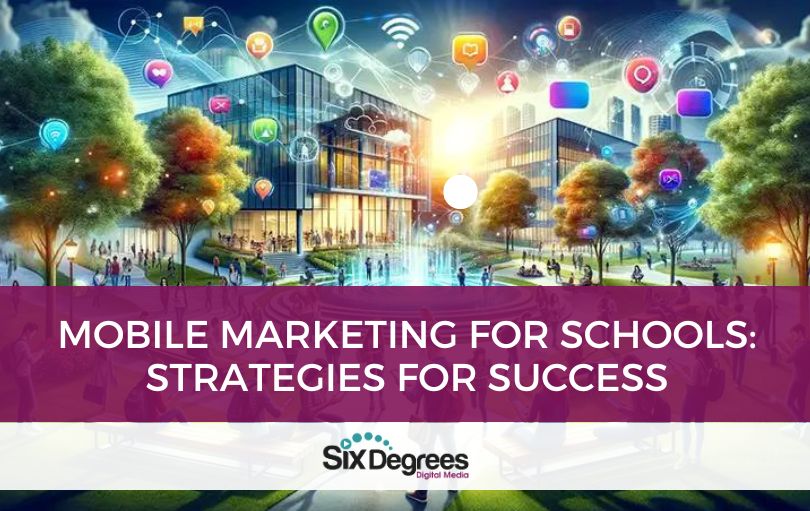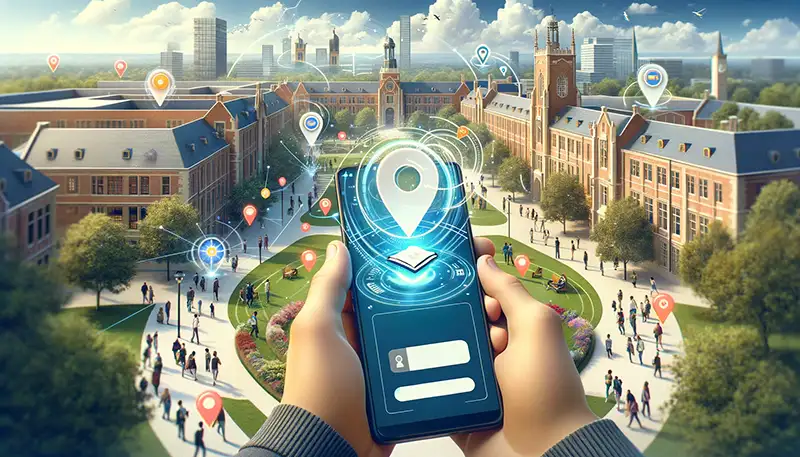In an era where smartphones are as ubiquitous as textbooks on a college campus, mobile devices have reshaped the contours of modern marketing strategies. For colleges and universities, this shift is not just a trend but a pivotal change.
The digital transformation offers unparalleled opportunities to reach students directly on their devices. Yet, it also presents the challenge of making meaningful connections in a crowded digital space.
The landscape of higher education is evolving, driven by digital natives who navigate their world through smartphone screens. For marketing at these institutions, leveraging mobile marketing strategies is now essential.
This introduction sets the stage for a deep dive into mobile marketing for schools. We’ll explore the challenges and promising opportunities that lie in engaging students and boosting enrollment through mobile channels.
The Current Landscape
Understanding the Shift
The digital age has ushered in a seismic shift towards mobile usage, fundamentally altering how the younger generation interacts with the world around them. Millennials and Gen Z, the primary target demographic for higher education institutions, are not just familiar with mobile technology; they live on it.
This shift is not merely about the technology itself but about how it has changed expectations. Today’s students expect information to be readily available, easily accessible, and engaging on their mobile devices. This reality underscores the need for a mobile-first marketing strategy that doesn’t just reach out to potential students but meets them where they are: on their phones.
The Challenge at Hand
However, navigating the mobile marketing landscape is fraught with challenges for colleges and universities. One major hurdle is creating content that not only captures attention but also keeps it. In a world brimming with distractions, engaging prospective students through mobile channels requires content that is not just informative but also compelling and interactive.
Another challenge lies in the personalization of communication. The one-size-fits-all approach is obsolete. Students today seek personalized experiences that reflect their interests, aspirations, and academic goals. Tailoring communication for diverse audiences without losing the personal touch is a delicate balance to strike.
Moreover, the technical aspects of mobile marketing—such as optimizing websites for mobile use, ensuring quick load times, and making navigation intuitive—pose significant challenges. These elements are crucial for a positive user experience, which can significantly impact a prospective student’s perception of an institution.
Lastly, measuring the effectiveness of mobile marketing efforts presents its own set of challenges. With a plethora of metrics and analytics tools available, determining which ones offer meaningful insights into engagement and conversion rates requires a strategic approach.
In summary, while the shift towards mobile usage offers tremendous opportunities for higher education marketing, it also brings challenges that demand innovative solutions. Understanding these challenges is the first step towards developing effective mobile marketing strategies that resonate with today’s students.
Bridging the Gap with Mobile Optimization
Website Optimization
In the quest to connect with the digital-first generation, optimizing your college’s website for mobile is no longer just an option; it’s a necessity. Here are some actionable tips to ensure your site not only welcomes mobile users but engages them:
- Speed is Key: A slow-loading website is a fast track to losing potential students’ interest. Aim for load times of 3 seconds or less to keep them engaged.
- Responsive Design: Your site should look great and function flawlessly across all devices. A responsive design automatically adjusts to fit the screen it’s viewed on, ensuring an optimal user experience.
- Simplify Navigation: Mobile users don’t have the patience for complicated menus. Streamline your site’s navigation to make it intuitive and effortless to explore.
Incorporating these elements enhances your website’s usability, making it a welcoming gateway for prospective students on their mobile devices.
Video Content Accessibility
In today’s fast-paced digital world, video content reigns supreme. However, ensuring that this powerful tool is optimized for mobile users can significantly amplify its impact. Consider the following:
- Optimize for Mobile Viewing: Videos should load quickly and display correctly on all screen sizes. Remember, poor video performance can deter potential students.
- Case Study Insights: The University of Birmingham’s successful video campaign serves as a prime example. By creating engaging video content optimized for mobile viewing, they significantly increased engagement and interest among prospective students.
Making your video content accessible and engaging for mobile users not only captures their attention but also provides them with valuable insights into what your institution has to offer.
By prioritizing mobile optimization in your digital marketing strategy, you bridge the gap between your college and the next generation of students. This approach not only meets them where they are but also demonstrates your commitment to providing a seamless and engaging digital experience. Ready to take your mobile marketing to the next level? Schedule a free strategy session with us today, and let’s explore how we can transform your college’s mobile presence together.
Engaging Through Social Media and Messaging
Social Media Strategies
In the digital landscape, social media platforms are the bustling town squares where the youth gather, share, and engage. For colleges looking to connect with prospective students, these platforms offer a goldmine of opportunities. Here’s how to harness their power:
- Platform Diversity: Understand that different platforms appeal to different segments of your audience. Instagram and TikTok, with their visual and dynamic content, are hits among younger demographics, while Facebook and LinkedIn might resonate more with mature students and alumni.
- Content Variety: Mix up your content to keep it fresh and engaging. Use a blend of informative posts, success stories, live sessions, and virtual tours to paint a comprehensive picture of campus life.
- Engagement Is Key: Social media is a two-way street. Encourage interaction by posing questions, running polls, and responding to comments. This engagement fosters a sense of community and belonging, crucial for drawing students to your institution.
The Power of SMS and Messaging Apps
While social media shines in broadcasting messages far and wide, SMS and messaging apps offer a more intimate way to communicate. Here’s why they’re invaluable in your mobile marketing toolkit:
- Direct Line to Students: SMS and messaging apps provide a direct channel to potential students, cutting through the digital noise. Personalized messages about application deadlines, open days, or course information can make recipients feel seen and valued.
- High Open Rates: Text messages boast an astonishing open rate, ensuring that your message not only reaches its destination but also commands attention.
- Engagement Boost: Personalized messaging campaigns, especially when they invite questions or feedback, significantly increase engagement and inquiry rates. They create a dialogue that can guide prospective students through the decision-making process.
Leveraging social media and messaging apps in your mobile marketing strategy transforms the way colleges interact with prospective students. It shifts the narrative from simply disseminating information to creating meaningful connections and engaging conversations. This approach not only elevates your institution’s presence in the digital sphere but also deeply resonates with the very audience you aim to attract.
By weaving together the broad reach of social media with the personalized touch of SMS and messaging apps, colleges can create a holistic engagement strategy. This dual approach caters to the diverse preferences of today’s students, ensuring your message is both heard and felt. Ready to amplify your engagement and connect on a deeper level? Let’s discuss how these strategies can be tailored to your college’s unique goals in a free strategy session.
Location-Based Marketing and Content Strategies
Utilizing Location for Engagement
Imagine walking through a bustling campus, your phone buzzes, and it’s a personalized message from the nearby college inviting you to an open day, tailored just for your interests. Welcome to the power of location-based marketing, a strategy that uses geographical data to target prospective students effectively. Here’s why it’s a game-changer:
- Precision Targeting: By using GPS and geofencing technology, colleges can send tailored messages and ads to individuals within a specific area. This precision ensures your message is relevant to the receiver, increasing engagement rates.
- Timely Communication: Location-based marketing allows institutions to reach potential students at opportune moments, such as when they’re near your campus or attending a college fair, making your communication efforts timely and contextually relevant.
This approach not only boosts engagement but also fosters a sense of immediacy and connection with prospective students, showcasing your institution as forward-thinking and attentive.
Content as a Connection Tool
In the digital age, content is more than just information; it’s a bridge to your audience’s heart and mind. Here’s how content marketing can narrate your school’s story, build trust, and deepen engagement:
- Telling Your Story: Use blog posts, videos, and social media to share your college’s history, achievements, and unique offerings. Storytelling invites prospective students into your world, making them feel a part of your community even before they enroll.
- Building Trust Through Value: Providing valuable content that helps prospective students navigate their educational journey (e.g., tips on choosing the right course, financial aid guidance) establishes your institution as a trusted advisor.
- Engaging on a Deeper Level: Interactive content like quizzes, virtual campus tours, and webinars can engage potential students more deeply, encouraging them to explore what it truly means to be part of your academic community.
Content marketing, done right, not only informs but also inspires and connects, turning prospective students from passive observers into active participants eager to start on their educational journey with your institution.
Actionable Insights and Optimization
Implementing Effective CTAs
In the realm of mobile marketing, the call to action (CTA) isn’t just a button or a line of text; it’s the critical leap from interest to action. For colleges striving to engage prospective students, the CTA is where the journey begins. Here’s how to make it count:
- Clarity is King: Your CTA should leave no room for doubt about what you want the user to do next. Whether it’s “Apply Now,” “Download Our Course Guide,” or “Join Our Virtual Open Day,” the action must be clear and compelling.
- Make It Pop: On mobile devices, attention is a scarce commodity. Your CTA should stand out visually, drawing the eye amidst a sea of content. Using contrasting colors, bold text, and strategic placement can make all the difference.
- Tap into Emotion: Leveraging psychological triggers like urgency (“Don’t miss out!”) or belonging (“Join our community!”) can significantly boost CTA effectiveness. Make it resonate on a personal level, and they’re more likely to take action.
Measuring Success
Launching a mobile marketing campaign is just the beginning. The key to long-term success lies in measuring, analyzing, and optimizing your efforts. Here’s how to ensure your strategy remains not just active but effective:
- Set Clear Goals: Before diving into analytics, know what success looks like. Is it more applications? Increased campus tour sign-ups? Define your objectives clearly to measure what matters most.
- Embrace Analytics: Tools like Google Analytics offer a wealth of data on website traffic, user behavior, and conversion rates. Dive into this data to understand how users interact with your mobile content and where you can improve.
- Test and Learn: The digital landscape is ever-evolving, and so should your strategies. Use A/B testing to compare different versions of your content, CTAs, and campaigns. Learn from the results and adapt your approach for better outcomes.
Optimizing your mobile marketing efforts is an ongoing journey of discovery and improvement. By crafting clear, compelling CTAs and diving deep into analytics, you can refine your strategies, better connect with prospective students, and ultimately, achieve your enrollment goals.
Next Steps Towards Transformation
We’ve journeyed through the digital landscape of mobile marketing for colleges, uncovering strategies that can transform engagement and enrollment. From embracing a mobile-first approach and optimizing websites for the on-the-go user to leveraging the dynamic world of social media and crafting messages that move hearts and minds, the path to connectivity with your audience is clear. The potential for a well-executed mobile marketing strategy to not only reach but deeply resonate with prospective students is immense, promising not just increased enrollment but the cultivation of lasting relationships.
Now, imagine taking these insights and strategies, tailoring them to the unique fabric of your institution, and weaving a narrative that captures the essence of your campus life. This is where transformation begins. Are you ready to elevate your college’s mobile marketing and create a future where every prospective student feels seen, understood, and inspired to join your community?
Let’s create your transformation together. Schedule your free strategy session with us today. Together, we’ll explore bespoke strategies that align with your goals, ensuring your institution stands out in the digital age. The next chapter of your college’s story is waiting to be written—let’s make it remarkable.

















